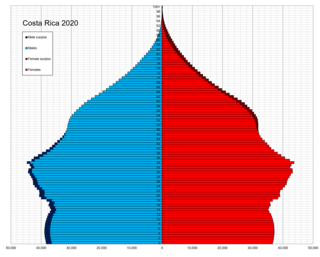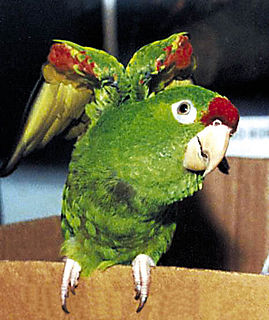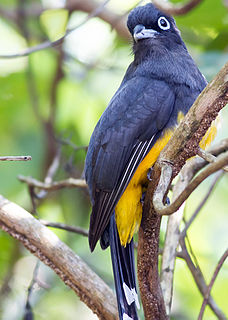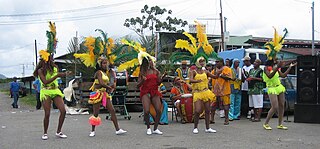
Costa Rica, officially the Republic of Costa Rica, is a country in Central America, bordered by Nicaragua to the north, the Caribbean Sea to the northeast, Panama to the southeast, the Pacific Ocean to the southwest, and Ecuador to the south of Cocos Island. It has a population of around 5 million in a land area of 51,060 square kilometers. An estimated 333,980 people live in the capital and largest city, San José, with around 2 million people in the surrounding metropolitan area.

This article is about the demographic features of the population of Costa Rica, including population density, ethnicity, education level, health of the populace, economic status, religious affiliations and other aspects of the population.

The Costa Rica national football team represents Costa Rica in men's international football. The national team is administered by the Costa Rican Football Federation (FEDEFUTBOL), the governing body for football in Costa Rica. It has been a member of the Fédération Internationale de Football Association (FIFA) since 1927, the Confederation of North, Central American and Caribbean Association Football (CONCACAF) since 1961, and a member of the Central American Football Union (UNCAF) since 1990.

The lineated woodpecker is a very large woodpecker which is a resident breeding bird from southern Mexico to northern Argentina and on Trinidad in the Caribbean.

The crimson-collared tanager is a rather small Middle American songbird. It was first described by the French naturalist René-Primevère Lesson in 1831, its specific epithet from the Latin adjective sanguinolentus, "bloodied", referring to its red plumage.

The black-cheeked warbler is a New World warbler, resident breeding bird endemic to the Talamancan montane forests of Costa Rica and western Panama.

The black-capped pygmy tyrant is the smallest passerine bird in its range, though larger than its cousin, the short-tailed pygmy tyrant. This tyrant flycatcher occurs from Costa Rica to north-western Ecuador.

The white-eared ground sparrow is a large American sparrow which breeds in a small range of Central America at middle altitudes from southern Mexico and Guatemala to northern Costa Rica. The species range is on the Pacific side of Central America, and Belize and Honduras are not in its normal range.
Mangue, also known as Chorotega, is an extinct Oto-Manguean language indigenous to Nicaragua, Honduras and Costa Rica. The ethnic population numbered around 10,000 in 1981. Chorotega-speaking peoples included the Mangue and Monimbo. The dialects were known as: Mangue proper in western Nicaragua, which was further subdivided into Dirian and Nagrandan; Choluteca in the region of Honduras' Bay of Fonseca; and Orotiña in Costa Rica's Nicoya Peninsula.

The crimson-fronted parakeet, also known as Finsch's parakeet or Finsch's conure, is a small green Neotropical parrot. It is found in Nicaragua, Costa Rica and western Panama. Its natural habitats are subtropical or tropical moist lowland forest and heavily degraded former forest.

The black-headed trogon is a species of bird in the family Trogonidae. It is found in Belize, Costa Rica, El Salvador, Guatemala, Honduras, Mexico, and Nicaragua. Its natural habitats are subtropical or tropical dry forest, subtropical or tropical moist lowland forest, and heavily degraded former forest.

Afro–Costa Ricans are Costa Ricans of African ancestry.

Jamaicans are the citizens of Jamaica and their descendants in the Jamaican diaspora. The vast majority of Jamaicans are of African descent, with minorities of Europeans, East Indians, Chinese, Middle Eastern, and others of mixed ancestry. The bulk of the Jamaican diaspora resides in other Anglophone countries, namely Canada, the United States and the United Kingdom and, to a lesser extent, other Caribbean countries and Commonwealth realms. Outside of Anglophone countries, the largest Jamaican diaspora community lives in Costa Rica, where Jamaicans make up a significant percentage of the population.

Cabanis's ground sparrow or Costa Rican ground sparrow(Melozone cabanisi), is an American sparrow. It previously was considered a subspecies of the Prevost's ground sparrow.
Hysterocladia is a genus of moths in the family Megalopygidae.
Episcepsis frances is a moth of the family Erebidae. It was described by Harrison Gray Dyar Jr. in 1910. It is found in Mexico, Costa Rica, Venezuela, French Guiana, British Guiana, and Peru.
Episcepsis gnomoides is a moth of the family Erebidae. It was described by William Schaus in 1910. It is found in Costa Rica.
Episcepsis lamia is a moth of the family Erebidae. It was described by Arthur Gardiner Butler in 1877. It is found in the Amazon region, Guatemala and Costa Rica.

Parque Nacional Simón Bolívar is an urban park of approximately 14 hectares, located in downtown San José, Costa Rica. It is the oldest botanical garden and zoo in Costa Rica. The name pays homage to Latin American national founder Simón Bolívar. It is administered by a conservation nonprofit foundation called Fundazoo. All animals in the zoo are orphaned, injured or have been disabled and are nursed back to health in hopes of releasing them.
Hysterocladia corallocera is a moth of the Megalopygidae family. It was described by Felder in 1874. It is found in Venezuela and French Guiana.













